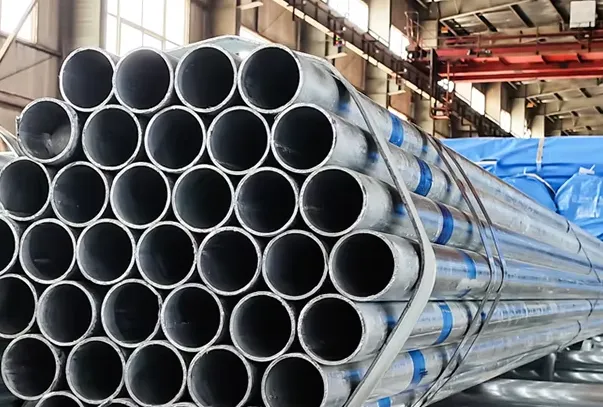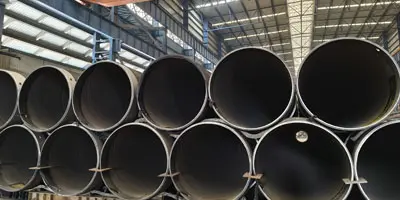As a common anti-corrosion steel, galvanized pipes are widely used in construction, transportation, agriculture, machinery manufacturing and other fields. With its excellent weather resistance and economic practicality, galvanized pipes play an important role in all walks of life. So, what are the specific categories of galvanized pipes? What are the differences between different galvanizing processes? This article will give you a systematic analysis.
What is galvanized pipe?
Galvanized pipe refers to a layer of zinc on the surface of the steel pipe to protect the steel substrate from corrosion and oxidation. Zinc, as a sacrificial anode material, can extend the service life of the steel pipe in harsh environments and improve its overall durability. Seamless steel pipes and welded steel pipes can be galvanized.
Classification of galvanized pipes: Galvanized steel pipes are divided into cold-dip pipes and hot-dip pipes.
Classification by galvanizing method
1. Hot-dip galvanized pipes
Hot-dip galvanized pipes are made by reacting molten metal with the iron matrix to produce an alloy layer, thereby combining the matrix and the coating. Hot-dip galvanizing is to pickle the steel pipe first. In order to remove the iron oxide on the surface of the steel pipe, after pickling, it is cleaned in an ammonium chloride or zinc chloride aqueous solution or a mixed aqueous solution of ammonium chloride and zinc chloride, and then sent to the hot-dip galvanizing tank. Hot-dip galvanizing has the advantages of uniform coating, strong adhesion, and long service life.
2. Cold-dip galvanized pipes
Cold-dip galvanizing is electrogalvanizing. The amount of galvanizing is very small, only 10-50g/m2, and its own corrosion resistance is much worse than that of hot-dip galvanized pipes. Formal galvanized pipe manufacturers, in order to ensure quality, mostly do not use electroplating Zinc (cold plating). Only small enterprises with small scale and outdated equipment use electrogalvanizing, and of course their prices are relatively cheaper. At present, the Ministry of Construction has officially issued an order to eliminate cold-dip galvanized pipes with backward technology, and cold-dip galvanized pipes are not allowed to be used as water and gas pipes in the future.
3. Hot-dip galvanized steel pipe
The steel pipe matrix undergoes complex physical and chemical reactions with the molten plating solution to form a corrosion-resistant and tightly structured zinc-iron alloy layer. The alloy layer is integrated with the pure zinc layer and the steel pipe matrix. Therefore, it has strong corrosion resistance.
4. Cold-dip galvanized steel pipe
The zinc layer is an electroplated layer, and the zinc layer and the steel pipe matrix are independently layered. The zinc layer is thin, and the zinc layer is simply attached to the steel pipe matrix and is easy to fall off. Therefore, its corrosion resistance is poor. In newly built houses, it is forbidden to use cold-dip galvanized steel pipes as water supply pipes.
Classification by pipe shape
(1) Galvanized round pipe
The most common shape, widely used, such as water supply pipes, scaffolding, fence pipes, etc.
The cross-section is square, suitable for frame structure, such as photovoltaic brackets, door and window frames, billboard support structures, etc.
The length and width are different, which can provide good bearing capacity and aesthetic effect. It is often used in building decoration and large mechanical equipment structure.
Before galvanizing, steel pipes must undergo pre-plating treatment:
That is, pickling, cleaning, rinsing, dipping in solvents, and drying. The welded pipe is hoisted by a crane to the pickling tank for pickling (about 2 tons per hoist). Pickling is performed with a hydrochloric acid solution of about 26%. In order to prevent excessive pickling and acid mist volatilization, 0.5~1.0g/L of corrosion inhibitor and mist inhibitor are added to the pickling solution. Pickling is performed at room temperature. The pickling time is generally 30~60 minutes. In order to ensure uniform pickling of the steel pipe, the steel pipe is lifted 2~3 times by a crane during the pickling process to improve the pickling effect. When the acid concentration drops to 100g/L, it should be supplemented or replaced, and the iron content reaches 220~260g/L and is discharged as waste acid. After pickling, the steel pipe is hoisted by a crane to a cleaning tank for cleaning to remove the residual acid and iron salt accumulated on the surface of the steel pipe after pickling, and then hoisted to a washing stand for washing with 0.7~0.8Mpa clean water. After the water drips dry, the steel pipe is hoisted to a solvent tank for dipping. The dipping time is about one minute. The solvent uses 600~650g/L zinc chloride and 80~100g/L ammonium chloride and 1~2g/L OP-10 surfactant. In order to improve the pre-plating effect of the steel pipe in the solvent, the solvent is always kept weakly alkaline, and then hoisted by a crane to a drying furnace stand and dried in the drying furnace. The drying temperature is 100~130 degrees, and the time is generally 6~10 minutes.
Optimization of sulfate galvanizing The advantages of sulfate galvanized pipes are that the current efficiency is as high as * and the deposition rate is fast, which is unmatched by other galvanizing processes.

Description of the process flow of galvanized pipes
1. Hot-dip galvanizing process
Pretreatment:
Including degreasing, rust removal (pickling), water washing and plating agent treatment to ensure that the surface of the steel pipe is clean, oil-free and rust-free.
Drying and preheating:
Heat the treated steel pipe to remove surface moisture and improve the adhesion during zinc dipping.
Hot-dip galvanizing:
Immerse the steel pipe in high-temperature molten zinc liquid, and the zinc reacts with the steel surface to form a dense zinc-iron alloy layer.
Cooling and passivation:
The galvanized steel pipe is cooled quickly, and the surface of some products needs to be passivated to increase the resistance to white rust.
Inspection and packaging:
Carry out coating thickness inspection and appearance quality inspection, and pack and ship after passing the inspection.
2. Cold galvanizing process
Surface cleaning:
Remove oil, rust and other impurities on the surface of the steel pipe by chemical or mechanical means.
Electrogalvanizing:
The steel pipe is used as the cathode and placed in an electrolyte containing zinc salts to pass electricity, so that zinc ions are deposited on the surface of the steel pipe to form a thin zinc layer.
Post-treatment and drying:
After cleaning and passivation (such as phosphating), it is dried and packaged.
How to choose the right galvanized pipe?
If high corrosion resistance and long-term outdoor use are required, it is recommended to give priority to hot-dip galvanized pipes.
If it is only used indoors or for temporary structures, cold-dip galvanized pipes with higher cost performance can be considered.
When purchasing, you should also pay attention to the coating thickness, dimensional tolerance, weld quality and manufacturer qualifications to ensure the quality of the project and service life.
Conclusion
As an economical, practical and high-performance structural material, galvanized pipes have an irreplaceable position in modern engineering. Understanding the classification and process of galvanized pipes can not only help us choose products more scientifically, but also effectively improve the safety and durability of the project.
Want to know more about the price, specification standards and application cases of
galvanized pipes? Welcome to follow
BAOWI Steel, we will continue to provide you with first-hand industry information and high-quality solutions!






 English
English Español
Español بالعربية
بالعربية











 Phone :
Phone :  Whatsapp :
Whatsapp :  Email :
Email : 


